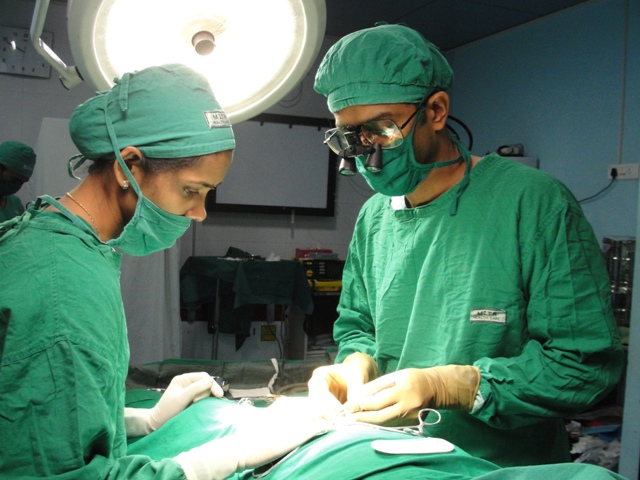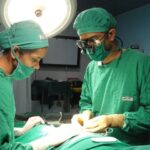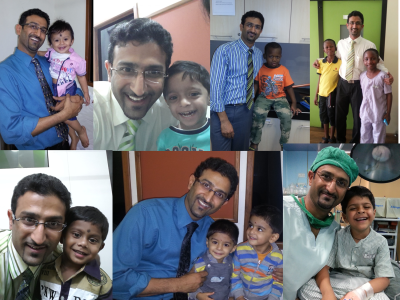Hypospadias remains one of the most common urological anomalies across the globe affecting almost 1/150 newborn boys. No nation or economic status or religion is exempt from its occurrence. The art and science of hypospadias treatment has evolved significantly in the last two years with a single stage repair of hypospadias a real possibility in most of the cases. The results of hypospadias surgery are of course better at centres where there are specialist hypospadias surgeons doing dedicated hypospadias treatment in large numbers every year. Even the complications of hypospadias surgeries decrease significantly with increasing experience. This was the aim with which we started Hypospadias Foundation in 2008. Now 6 years later, we are happy to provide excellent outcomes and give happiness to kids and families who travel to India from all over the world.
The Child from Great Britain
Master Narain was noted to have hypospadias as soon as he was born in England. The pediatrician advised the family to meet the pediatric surgeon or pediatric urologist when the child was three months old. Through the NHS system, the family went and met a Pediatric Surgeon who advised hypospadias repair surgery after 1.5-2 years of age.
Mother and father, both UK residents, were worried about delaying the surgery so much as somehow they felt that once the surgery is needed they better get it done at a younger age than a later age. They just couldn’t understand the point of waiting for the surgery which would anyway be required. With this dilemma about the age for hypospadias surgery, they contacted us at Hypospadias Foundation. After a few tele and online consultations they decided to travel to India for Hypospadias repair surgery with us at MITR Hospital in Navi Mumbai, India. We advised surgery between 6 months to one year of age. Finally, when Narain was 9 months old they traveled to India from England and visited us.
On examination, Narain had a distal penile hypospadias without any chordee. The urethral plate was pink and healthy and he seemed suitable for a single stage Hypospadias repair. Parents did not have too many questions and I was very surprised. When I asked, they said that they have read a lot of blogs written by me on hypospadias treatment and were upto date with what their son is going to go through. This was a very happy consultation indeed. Saved me time and energy but still I went through the pre and post hypospadias surgery routine with them explaining to them. They just nodded their heads and posted Narain for surgery one day later and meanwhile we got the blood/ urine tests and pre surgery fitness for anesthesia.
Surgery was done as first case in the morning the following day. Surgery was done under caudal analgesia and sevoflurane anesthesia. Since the urethral plate was good and the hypospadias was not very severe (distal penile hypospadias), we did a Tubularised incised plate urethroplasty also called Snodgrass repair urethroplasty. The surgery took only 75 minutes. Narain tolerated the procedure well and was to his usual playful self in a few hours after surgery. We sent him home by the next morning on usual oral medications for pain and bladder spasms and a mild antibiotic. One week later, the family visited us again in the outpatient clinic for removal of dressing and catheter. Narain passed urine well without any issues and had a good healing operative site at the time of hypospadias dressing removal. Another followup was scheduled at 10 days after catheter & dressing removal. Narain was passing urine in a good straight stream without any difficulty. Also the cosmetic result was excellent. The family was overjoyed and was able to travel back to England within three weeks of surgery. We requested the family to send us a short video of Narain passing urine and a few pictures of his penis at about 6 weeks and 3 months after surgery to confirm that everything has healed without any complication. We received these videos and pictures a week back and were happy to note that there was no complication of the surgery. We expect Narain to do very well and live a normal life after the hypospadias surgery.
About the author:
Dr A.K.Singal is a renowned Pediatric urologist and is considered one of the best hypospadias surgeons in India. He treats more than 100 kids with hypospadias every year at various hospitals in Navi Mumbai, Thane and Mumbai. Lot of kids travel from neighbouring cities such as Pune, Ahmedabad, Surat, Goa and as far as Bangalore, Hyderabad, Calcutta, Delhi, Jaipur, Chennai etc.
He can be contacted by filling up the form here: Contact form Dr A.K.Singal

Dr A.K.Singal during Hypospadias surgery
Watch Video of Distal Penile Hypospadias Repair Surgery by Dr A.K.Singal, expert hypospadias surgeon
Watch Video of Single stage surgery for severe scrotal hypospadias by Dr A.K.Singal, Hypospadias specialist surgeon
Contact Form for Hypospadias Foundation
Please fill all clinical details and upload pictures and clinical summaries (if available)


